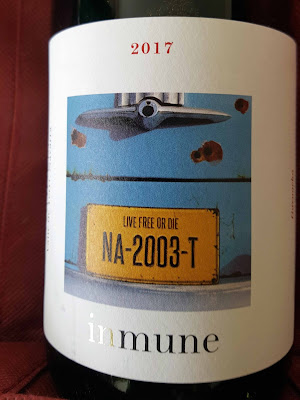Two excellent wines from South America feature in O'Brien's current promotion.
Dozens and dozens of wines are reduced in the current O'Brien's promotion that runs up to the end of the year. I've picked a few and have a couple of South American beauties below for you. Some of the others are pretty good too and I'll come to those in the next week or so. In the meantime, check out this magnificent Malbec from over 1,300 meters in the Andes foothills - that's higher than Carrauntoohill. The other, a Cinsault, a very pleasant light red, comes from the highly regard Di Martino winery in Chile.
Once upon a time, we bought red and white and maybe rosé. But now you'll see organic, biological, natural, even orange on labels. Can be confusing, I know. O'Brien's have put a handy leaflet together to explain the terms and I'll reproduce parts here from time to time. The first two are below - hope they help!
Casa de Uco El Salvaje Malbec Los Chacayes (IG) 2016, 13.5%, €16.95 (19.95)
Dozens and dozens of wines are reduced in the current O'Brien's promotion that runs up to the end of the year. I've picked a few and have a couple of South American beauties below for you. Some of the others are pretty good too and I'll come to those in the next week or so. In the meantime, check out this magnificent Malbec from over 1,300 meters in the Andes foothills - that's higher than Carrauntoohill. The other, a Cinsault, a very pleasant light red, comes from the highly regard Di Martino winery in Chile.
Once upon a time, we bought red and white and maybe rosé. But now you'll see organic, biological, natural, even orange on labels. Can be confusing, I know. O'Brien's have put a handy leaflet together to explain the terms and I'll reproduce parts here from time to time. The first two are below - hope they help!
Casa de Uco El Salvaje Malbec Los Chacayes (IG) 2016, 13.5%, €16.95 (19.95)
Purple is the colour of this organic wine from a high altitude vineyard in the Mendoza region of Argentina. The rich aromas of ripe dark fruit rise to meet you. And on the palate the big flavours (plum, dark cherry and blackberry) are matched by an excellent acidity, a harmony relayed to the decent finish (not overly long). An immediately engaging wine and Very Highly Recommended. Just 2,500 bottles are produced and the wine has been fermented in large concrete eggs.
Los Chacayes is one of four wine areas in Tunuyan in the Uco valley. The vineyard Casa de Uco is located in the valley, tucked against the foothills of the Andes Mountains, and close to Mendoza. El Salvaje (wild) also figures prominently on the label and is the overall name given to a series of organic wines that also includes, among others, a Pinot Noir and a white blend.
This wine is 100% Malbec from certified organic vineyards located at 1300 metres above sea level. This elevation maintains the fresh acidity in the grapes. Unoaked, this is a pure expression of the Uco Valley terroir.
Enjoy with beef, lamb or char-grilled vegetables. In Argentina, I’m told they pair it with juicy Sirloin of pork, Braised lamb shoulder with roasted parsnips, or Fillet steak with chimichurri. Wine Folly says the perfect Malbec Food Pairing is Black pepper buffalo burgers with blue cheese mushrooms and rosemary infused garlic kale chips. Sounds great to me.
Alberto Antonini, Winemaker Casa de Uco, is enthusiastic: "After 16 years of experience in the Uco Valley, I can affirm that this is the exact area where the best wines of Mendoza are produced. The proximity to the Andes Mountains, the ideal day to night temperature ranges, and the fertile soil with excellent drainage, make this land exceptional to produce high end wines and develop the viticulture and enology in the most natural way possible"
De Martino “Gallardia” Cinsault Itata (DO) 2017, 13%, 14.95 (19.95)
This delightful 100% Cinsault is a light ruby, quite like Pinot Noir. Aromas are rather intense: red fruit (including raspberry) mainly, plus floral elements. Mouthfeel is soft. Smooth and fresh on the palate, the raspberry prominent again, good acidity too, and a pleasing finish as well. Highly Recommended. Maybe Very Highly Recommended if you love these light dry reds as many people do nowadays.
De Martino say this, from their Guarilihue vineyard (22km from the sea), “is a tribute to the coastal vineyards located by the southern region of Chile; it is the cradle of the country’s viticulture, with vines dating back to 1551…. A sustainable agriculture, including dry farming and ploughing with horses are practiced in our vineyards.”
Wines of South America has a very high regard for De Martino and have included some of their wines in Top Ten varietal lists. De Martino winemaker Marcelo Retamal is one of the country’s most accomplished and is known as el doctor. “He uses no new oak, preferring larger older casks, nd promotes the use of the old ceramic tinjaras, clay amphorae, for fermentation. There are no cultivated yeasts, no filtration, and no intervention.”


























